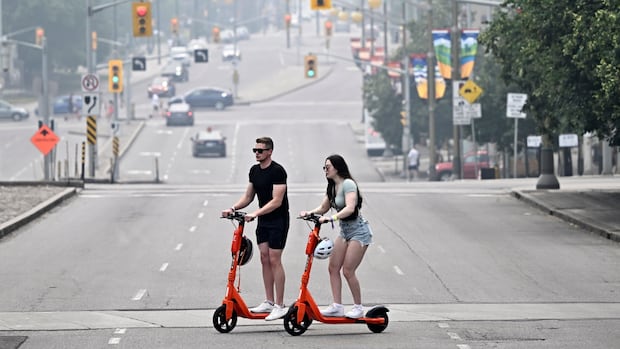Hospitalizations related to injuries from scooters and e-scooters have risen, according to new Canadian data, as emergency physicians warn the two-wheeled vehicles aren’t toys.
The Canadian Institute for Health Information (CIHI) said Thursday that nearly 1,000 people were hospitalized for scooter-related injuries during the 12-month period starting April 1, 2023. That’s up from 810 during the same period of 2022-23.
Half of the injuries — 498 — were related to motorized e-scooters, an increase of 32 per cent over the 375 hospitalizations recorded in 2022-23.
“Some unintentional injuries are really predictable and preventable, particularly in relation to e-scooter injuries,” said Tanya Khan, CIHI’s manager of hospital data advancement and engagement in Montreal.
Emergency physicians say the extent of injuries can be severe: brain, facial and dental trauma, fractures needing multiple surgeries, or traumatic brain injuries that require intensive care.
Some injuries happen when the rider is hit by a car, but physicians are also treating people who have been hit by a rider.
Back in 2020, Toronto’s Hospital for Sick Children (SickKids) saw a single e-scooter injury. By 2024, that number had jumped to 46.
Fast speeds on unstable devices
Daniel Rosenfield, a pediatric emergency physician at SickKids, said the hospital saw 16 scooter-related injuries this May alone, compared with three or fewer during the same month in previous years.
Rosenfield said injuries can range from bumps and fractures to life-changing head injuries and internal bleeding that need a whole trauma team or intensive care.
“This can be anything from just one or two surgeries to full recovery, to lifelong injuries needing rehabilitation hospitals and complete kind of neurologic devastation,” Rosenfield said.
Given what he has seen, Rosenfield implores parents not to buy e-scooters for children. “They are not toys.”
An e-scooter crash earlier this summer left Jackie Gravel, 61, with a broken jaw and the inability to eat solid foods for six weeks.
People need physical maturity to operate e-scooters, Rosenfield said.
“From an emotional and cognitive perspective — where you just have the ability to understand where your body is in space, how you can make turns, what’s far ahead and what’s not — [it is] similar to driving a car.”
E-scooters can go from zero to 40 km/h in seconds, and many parents aren’t aware of that, he said.
At SickKids, almost 90 per cent of e-scooter injuries are among teenage boys. Most of them weren’t wearing helmets.
The hospital’s injury rates also showed an increase among children aged four to six riding with a parent or older sibling.
“If you have speed plus head injury, a helmet will help mitigate those injuries every time,” he said.
Pamela Fuselli, president and CEO of Parachute, an injury prevention charity, said micro-mobility devices like e-scooters have small wheels and are unstable when being ridden.
“Inexperience comes into play,” Fuselli said. “Take some time to learn how to use these devices.”
She says all users should wear helmets, obey the rules of the road, including speed and alcohol limits, and respect other road users.
Noting that provincial and municipal laws and regulations on using e-scooters vary across Canada, Fuselli said stepping up enforcement is important to prevent injuries.

